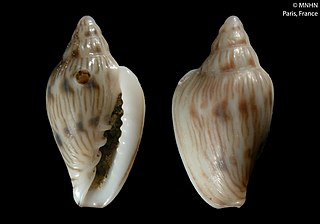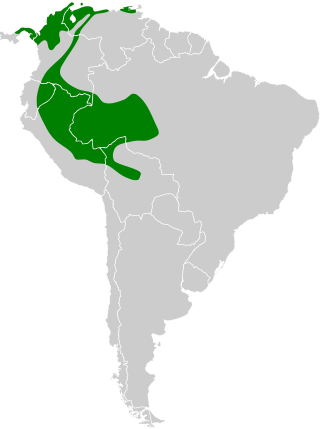
Bovines comprise a diverse group of 10 genera of medium to large-sized ungulates, including cattle, bison, African buffalo, water buffalos, and the four-horned and spiral-horned antelopes. The evolutionary relationship between the members of the group is still debated, and their classification into loose tribes rather than formal subgroups reflects this uncertainty. General characteristics include cloven hooves and usually at least one of the sexes of a species having true horns. The largest extant bovine is the gaur.
The masked yellowthroat is a New World warbler. It has a number of separate resident breeding populations in South America. The black-lored yellowthroat and southern yellowthroat were formerly considered subspecies.

The white-chinned petrel also known as the Cape hen and shoemaker, is a large shearwater in the family Procellariidae. It ranges around the Southern Ocean as far north as southern Australia, Peru and Namibia, and breeds colonially on scattered islands. The white-chinned petrel was formerly considered to be conspecific with the spectacled petrel.

The Hypostominae are a subfamily of catfishes of the family Loricariidae. Most members are restricted to tropical and subtropical South America, but there are also several species in southern Central America. Hypostomus plecostomus, which is popular in the aquarium trade, has been introduced to several regions far from its native range.

The bokikokiko, Kiritimati reed warbler or Christmas Island warbler is a species of warbler in the family Acrocephalidae. It is found only on Kiritimati and Washington Island (Kiribati).

The rufous crab hawk or rufous crab-hawk, is a Near Threatened species of bird of prey in subfamily Accipitrinae, the "true" hawks, of family Accipitridae. It is found on Trinidad and along the South American coastline from eastern Venezuela to southern Brazil.
Arctides guineensis is a species of slipper lobster that lives in the Bermuda Triangle. It is known in Bermuda as the small Spanish lobster, a name which is also favoured by the FAO.

Scyllarides aequinoctialis is a species of slipper lobster that lives in the western Atlantic Ocean from South Carolina to São Paulo State, Brazil, including the Gulf of Mexico, Caribbean Sea, and Bermuda. Its common name is Spanish slipper lobster. It grows up to 30 centimetres (12 in) long, with a carapace 12 cm (4.7 in) long. S. aequinoctialis is the type species of the genus Scyllarides and the first species of slipper lobster to be described from the Western Atlantic.

Marginella aequinoctialis is a species of sea snail, a marine gastropod mollusk in the family Marginellidae, the margin snails.

Pseudozonaria is a genus of sea snails, marine gastropod mollusks in the subfamily Zonariinae of the family Cypraeidae, the cowries.
Pheropsophus aequinoctialis is a species of ground beetle from Central and South America that feeds as larvae on the eggs of mole crickets but as an adult is a generalist feeder.
Tulbaghia aequinoctialis is a plant in the family Amaryllidaceae native to Angola. It was first described to science in 1878.

Phaeoxantha bifasciata is a species of tiger beetle in the subfamily Cicindelinae that was described by Brullé in 1837, though for most of the past 200 years it has erroneously been recognized under the name aequinoctialis, a name based on a misidentified bombardier beetle. The species is found in South American countries like Argentina, Bolivia, Brazil, Colombia, Ecuador, French Guiana, Peru, and Venezuela.

Lemna aequinoctialis, the lesser duckweed, is a tiny, floating aquatic plant in the aroid family, found in quiet, still waters of the Southern U.S., as well as México and some Caribbean Islands. Additionally, it can be found from the state of Virginia south through Florida, north to Nebraska and even into southern Wisconsin. It is also widespread in the American Southwest, from Texas to the coast of California, preferring lagoons and still ponds, which it accesses via seasonal flooding and occasional precipitation. Fronds are generally triple-nerved, green, and measure up-to 6 mm long. Flowers are single-ovulate, with a small utricular scale open on one side. Seeds have 8–26 ribs.
Transancistrus is a genus of suckermouth armored catfishes native to South America.
Selenophorus aequinoctialis is a species of ground beetle in the family Carabidae. It is found in North America and South America.
Galerita aequinoctialis is a species of ground beetle in the family Carabidae. It is found in North America.
Transancistrus santarosensis is a species of catfish in the family Loricariidae. It is a freshwater fish native to South America, where it occurs in the basin of the Santa Rosa River, which is part of the Gulf of Guayaquil drainage in Ecuador. The species reaches 7.7 cm SL.

The western olivaceous flatbill is a species of bird in the family Tyrannidae.










